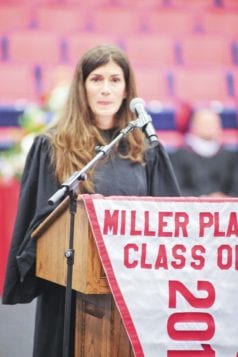1 of 17
Rocky Point hosted its graduation ceremony June 28 where graduating seniors braved an early summer heat wave to get their diplomas.
All Photos by David Luces
Rocky Point hosted its graduation ceremony June 28 where graduating seniors braved an early summer heat wave to get their diplomas.
All Photos by David Luces

Miller Place seniors accepted their diplomas away from home June 26, with the commencement ceremony instead hosted at Stony Brook University.
All photos by Bill Landon.
By Daniel Dunaief
They have the ability to call the body’s armed forces. They may interact with the immunological foot soldiers and, then, somehow, inactivate them, allowing the destructive cancer they may aid and abet to continue causing havoc.
This is one hypothesis about how a newly discovered class of fibroblasts may play a role in the progression of pancreatic cancer.
Ela Elyada, a postdoctoral fellow in David Tuveson’s lab at Cold Spring Harbor Lab, partnered up with Associate Professor Paul Robson at the Jackson Laboratory in Farmington, Connecticut, to find a new class of fibroblast in pancreatic cancer.
This cell, which they called antigen-presenting cancer-associated fibroblasts (or apCAFs) had the same kind of genes that are usually found in immune cells. Cells with these genes have signals on their surface that present antigens, or foreign parts of viruses and bacteria to helper T-cells. Elyada and Robson showed that the apCAFs can use their immune cell genes to present peptides to helper T-cells.
With the apCAFs, the researchers hypothesize that something about the immunological process goes awry, as the T-cells show up but don’t engage.
Elyada and Robson suspect that the activation process may be incomplete, which prevents the body’s own defense system from recognizing and attacking the unwelcome cancer cells.
While she was excited about the potential of finding a different type of cell, Elyada needed to convince herself, and the rest of the scientific community, that what she’d found was truly original, as opposed to a scientific mirage.
“We spent hours and hours trying to understand what is different in this type of cell,” Elyada said. “Like everything new you find, as a scientist, you really question yourself, ‘Is it real? Is it an artifact of the single cell?’ It was really important for me to do everything I could from every angle to make sure they were not macrophages that looked like fibroblasts or cancer cells that looked like fibroblasts.”
After considerable effort, Elyada was sure without a doubt that the group had found fibroblasts and that these specific cells, which typically are involved in connective tissue but which pancreatic cancer uses to form a shell around it, contained these immunological genes.
She sees these cells in different experiments from other people inside and outside the lab, which further supports her work and found the apCAFs in mice and human pancreatic ductal adenocarcinoma, which is the fourth leading cause of cancer-related deaths in the world.
The fibroblasts, which are not cancerous, play an unclear role in pancreatic cancer.
Elyada explained that single-cell sequencing enables scientists to look at individual cells, instead of at a whole population of cells. Scientists “have started to utilize this method to look at differences between cells we thought were the same,” she said. “It’s useful for looking at the fibroblast population. Scientists have appreciated that there’s probably a lot of heterogeneity,” but they hadn’t been able to describe or define it as well without this technique.
The results of this research, which was a collaboration between Elyada, Robson and others, were recently published in the journal Cancer Discovery. Robson said it was a “great example of how [single-cell RNA sequencing] can be very useful in revealing new biology, in this case, a new subtype of cancer-associated fibroblast.”
Earlier work in the labs of Robson and Tuveson, among others, have shown heterogeneity within cancer-associated fibroblast populations. These often carry a worse prognosis.
“We are very interested in continuing to explore this heterogeneity across tumor types and expect we will continue to find new subtypes and, although we have yet to confirm, would expect to see other solid tumor types to contain apCAFs,” Robson said.
“We still need to work hard to reveal their function in the full animal, but if they turn out to be tricking the immune cells, they could be a target for different immune-related inhibition methods,” explained Elyada.
The newly described fibroblast cells may be sending a signal to the T-cells and then either trapping or deactivating them. Elyada and Robson both said these results, which they developed after working together since 2016, have led to numerous other questions. They want to know how they work, what the mechanisms are that allow their formation, what signals they trigger in T-cells and many other questions.
Elyada is working with Pasquale Laise in Andrea Califano’s lab at Columbia University to gather additional information that uses this single-cell sequencing data.
Laise has “a unique way of analyzing [the information] to look at how the sequencing can predict if proteins are active or not active in a cell,” she said. Laise is able to predict the activity of transcription factors according to the expression level of their known target.
Elyada may be able to use this information to understand the source cell from which the fibroblasts are coming.
Originally from Israel, Elyada has been working as a postdoctoral researcher in Tuveson’s lab for about six years. She lives in Huntington Village with her husband Gal Nechooshtan, a postdoctoral researcher at Cold Spring Harbor Laboratory’s Woodbury complex. The couple has two daughters, Maayan, who is 10, and Yael, who is 8.
Elyada hopes to return to Israel next year, where she’d like to secure a job as a professor and build on the work she’s done at CSHL.“I definitely want to keep working on this. This would hopefully be a successful project in my future lab.”
On July 1, Stony Brook Medicine announced the newest member of the Stony Brook University Hospital health care system — Eastern Long Island Hospital in Greenport.
The 90-bed, acute care hospital has been affiliated with Stony Brook since 2006, and in 2015, talks began between the two hospitals to form a partnership. The Greenport campus will now be referred to as Stony Brook Eastern Long Island Hospital.
“This really has been a win-win for both the hospital and for the people on the South Fork so let’s do it on the North Fork.”
— Dr. Kenneth Kaushansky
Dr. Kenneth Kaushansky, senior vice president of health sciences and dean of the Renaissance School of Medicine at Stony Brook University, said the partnership will allow SBELIH to work collaboratively with Stony Brook University Hospital and Stony Brook Southampton Hospital, which joined the health care system in 2017.
While Stony Brook Medicine takes on the responsibility of operating the campus when it comes to things such as finances and quality responsibility, Kaushansky said the health care system doesn’t own the other hospitals but leases the buildings from the owners, and staff members are not state employees and continue with the same salaries and unions as before.
He said the partnership with Southampton has been a successful one, and the same is expected with SBELIH.
“This really has been a win-win for both the hospital and for the people on the South Fork so let’s do it on the North Fork,” Kaushansky said.
Stony Brook expects to help grow the Greenport hospital’s staff. Residents of the North Fork, which SBELIH serves along with Shelter Island, now can receive additional resources, particularly specialized outpatient services. Kaushansky said another plus is the use of a telehealth program, which allows doctors and patients on the North Fork direct access to Stony Brook Medicine specialists.
Stony Brook also has its eyes on Long Island Community Hospital in East Patchogue, which Kaushansky said they are in talks with, to see if it makes sense to create a similar affiliation with the facility.
“We would anticipate that behavioral medicine will remain the core service at Eastern Long Island Hospital.”
— Dr. Margaret McGovern
“[It would be] another opportunity for us to grow our health care system, which will give us more bandwidth, give us more opportunity to keep patients as close to home as possible,” he said. “But when it comes time to need more advanced facilities, they have a seamless transition into Stony Brook Hospital.”
Dr. Margaret McGovern, vice president for health system clinical programs and strategy at Stony Brook Medicine, said the affiliation is another step on the path of the health care system expanding.
She and Kaushansky said the behavioral health programs of Eastern Long Island, which include medical-surgical services, critical care, psychiatry and drug and alcohol detoxification and rehabilitation services, are strong.
“We would anticipate that behavioral medicine will remain the core service at Eastern Long Island Hospital,” McGovern said.
Kaushansky added that with limited beds at the university hospital for behavioral health patients, it will be a benefit to be able to utilize SBELIH.
Paul Connor, chief administrative officer of SBELIH, said a psychiatric residency started at the Greenport campus July 1 as a part of Stony Brook Medicine’s academic mission. The CAO said training physicians and health care professionals is important for future staffing needs, as a high percentage of physicians are more apt to remain where they spent their residency.
“This was really an effort to preserve the mission of Eastern Long Island Hospital and ultimately to create more local health care options.”
— Paul Connor
Connor said the hospital opened in 1905 and was the first hospital in Suffolk County and the second one on Long Island.
“This was really an effort to preserve the mission of Eastern Long Island Hospital and ultimately to create more local health care options,” he said.
The hospital’s board will be part of a joint advisory committee with Stony Brook Medicine, he said, and will meet on a regular basis to discuss topics such as finances, planning and safety.
“They’re going to be in a position to influence the operation of the hospital as representatives from the community,” he said.
Connor said the ELIH Foundation will continue to exist and be independent of Stony Brook, which means any funds raised will go toward the SBELIH campus.
McGovern said while Stony Brook is a resource for other hospitals entering the system, providing services such as a burn unit, psychiatric emergency department and kidney transplant program, many patients prefer to be treated close to home.
“A lot of care is appropriate in a community hospital setting, so that’s the model we’re going with and complementing it with a robust outpatient ambulatory platform,” she said.
In addition to its strong behavioral health programs, SBELIH is also one of two hospitals on Long Island providing skin cancer screenings to all inpatients through its Mollie Biggane Melanoma Foundation.


There was much finality to this year’s school graduations at Comsewogue school district. As high school seniors got ready to leave for new horizons, superintendents Joe Rella will soon be leaving his position.
At Comsewogue High School, as the evening sun crept toward the horizon June 26
, blocking in the football field with the cooling shade of trees, as the students were graduating so was Rella, or at least that is how he said he saw it.
Rella was in for his own surprise, as he was brought on stage alongside incoming superintendent Jennifer Quinn and members of the school board. In front of the stage, graduates held up a sign reading Dr. Joseph V. Rella Performing Arts Center. Quinn announced the high school auditorium would now be sporting Rella’s name.
“Clearly you’re a lot smarter than I am. It took you four years to graduate high school, it took me almost 26,” Rella said, speaking to the students with a 2019 tassel on his hat. “Remember, wherever you go and whatever you do, you will always be one of us.”
Steven Nielsen, who lost his 17-year-old son James from a rare form of cancer a little less than a year ago, spoke to the graduating class about his son and what values he could share even after his untimely death.
“I think James is a good inspiration of how to live,” he said. “He was an amazing person, he was smart, he was handsome, he was extremely kind and unbelievably empathetic. Remember that, be kind, use that as an example. Think of other people in everything that you do.”
Underneath each of the graduates’ chairs, stuck into the rough metal seats, was a Pokémon card. These, Nielsen said, were there to represent each of them had the opportunity to “evolve.”
He and his wife Jean, both teachers in the Comsewogue School District, accepted a diploma in honor of their son, with Steven Nielsen holding the cap and gown his son would have worn to graduation.
To cap off Comsewogue’s graduation ceremony, as the scenery got dark, fireworks rose above the trees of a distant field, and all the newly graduated students stared up at the sky. Unknown to high school principal Joe Coniglione, the field lights would take several minutes to warm up, and so the graduates cheered in the dark, hats flying through the air like tasseled stars.
This past weekend, several parts of Long Island was hit by an unexpected flash wind and rain storm that took down numerous large trees, branches and electric wires across parts of Long Island. In the Town of Huntington, much of the northern and eastern parts of town were affected.
Over 80,000 homes and businesses across Long Island lost power due to the storms. 26,000, nearly one third of the total power outages, were spread across Huntington, Smithtown and Islip.
Huntington’s Highway, General Services and Maritime Services Departments worked through the night to clear roads and waterways of hazards created by the storm, working on over 750 service tickets.
Crews from Nassau County, upstate New York and out of state, including 48 Con Edison personnel and approximately 400 tree trim and line workers assisted.
General services crew leaders are completing damage assessment at all
Huntington town facilities and parks, municipal & commuter parking lots.
Tree and limb removal will take place at Veterans Park, Henry Ingraham Preserve, Heckscher Park, Caravan Park, Elwood Park, William Byrne Park, Cedar Road Park, Commack Park, Dix Hills Park & Golf course, and the Washington Drive Parking Lot.
The most extensive damage is at Crab Meadow Golf Course where approximately 35 trees are down, and hundreds of broken branches are on the ground or hanging in trees. The golf course is currently closed, and officials hope to have it opened for play by this Wednesday, June 3, even though tree removal operations will continue for several weeks.
The Dix Hills Pool was closed July 1 due to a power outage.
Officials said they expected half of all outages would have been restored by July 1 and 95% restored by midnight, July 2.
To report a downed wire and receive status updates on power call PSEG Long Island’s 24-hour Electric Service number at 1-800-490-0075.
To report downed trees blocking roads or branches suspended over roads, contact the Highway Department at (631) 499-0444 or huntingtonny.gov/highway.
Residents without power can keep cool at these Town of Huntington facilities:
The cars lined up along the drive to Earl L. Vandermeulen High School, and besides the sounds of running motors, the graduating seniors could express nothing but awe. The entire front face of the high school was dressed in a shawl of ’90s and early 2000s nostalgia. Above the entrance, dressed on a large orange blimp calling back to the classic Nickelodeon channel logo, was a sign reading Royalodeon.
The parents of the Port Jeff graduates and members of the prom committee spent hour upon hour of their own time to help construct the pieces to the prom in the months leading up to graduation, and the entire final construction, bringing it to the high school, was done over the previous weekend.
Port Jefferson residents got to experience their efforts the evening of July 1, before the students saw it for the first time. Inside was a splattering of ’90s cartoons, from “Teenage Mutant Ninja Turtles” to “The Wild Thornberrys” to “Rugrats,” and the entire dining area designed around “SpongeBob SquarePants.” Lanterns were dressed like jellyfish, hanging from the gym ceiling, and to one side a fully stocked glass case filled with candy was accompanied by cardboard stands of the characters from “Drake & Josh.”
Students arrived awed, not only by the design of the prom but also the number of parents who came to watch their kids walk the red carpet. Kids came ferried in sports cars, but some came in more outlandish style, arriving via boat, the Port Jefferson Jitney, a Qwik Rides Car and even a rickshaw.
A Shoreham man was killed this past Sunday after his motorcycle was involved in a crash with another car, Southold Town police said.
Jon Meeker was travelling eastbound on Route 25 driving a 2001 Suzuki motorcycle and attempted to pass a 2015 Jeep Cherokee on the right as it made a right turn onto Bailey Avenue shortly after 8 p.m., according to police.
Meeker was then thrown from his motorcycle and collided with a utility pole. The Shoreham man was transported to Eastern Long Island Hospital by members of the Greenport Fire Department where he later succumbed to his injuries.
Jennifer Feldstein of New York, the driver of the Jeep Cherokee, was not injured along with two other passengers in the car. Both vehicles were impounded for safety checks.
A GoFundMe page was set up on July 1 to provide contributions to the Meeker family.
“Jon worked three jobs to support his family, but the responsibility of two children in college, a daughter with a medical condition and funeral costs have overwhelmed the family financially,” the page reads. “Nothing was more important to Jon than his family. Any contributions will go directly to the family to address their most immediate needs during this difficult time.”
Within a day, over 250 people have raised upwards of $26,000 of the $75,000 goal.
The father of three is survived by his wife Kimberly, who works in Shoreham Wading-River School District, son Jake, who graduated from SWR High School this past week, and daughters Makayla and Ella.
Shoreham has been host to several tragedies over the past few years. Only recently 18-year-old Melissa Marchese, who was set to graduate from SWR, died in a car crash at the corner of Route 25A and Miller Avenue. The school district wore yellow ribbons and released doves in her honor at the commencement ceremony June 28.
For those looking to donate to the GoFundMe page visit here.
HAPPY RETURNS
Gerard Romano of Port Jefferson Station took this beautiful photo at the traffic circle near the Port Jefferson Country Club on June 21. He writes, ‘The daylilies have begun to bloom this year. In this photo I increased the level of contrast and shadow in the edit process to separate the flower from the background.’
Send your Photo of the Week to [email protected]
By Bob Lipinski

When the subject of wines from Australia is brought up, most people think of “critter” (Yellow Tail) labels, “fruit-bomb” shiraz and over-oaked chardonnay. Australia produces some excellent chardonnay, pinot noir and even sparkling wines.
Australia is a grape-growing country that is slightly smaller than the United States. Australia is divided into six grape-growing states (in descending order of production): South Australia, New South Wales, Victoria, Western Australia, Tasmania and Queensland. Wine is also made (to a lesser degree) in the Northern Territory. Within each state Australian appellations are subdivided into zones, regions, subregions and GIs (geographical indications).
Labeling laws
(Australian wine law, established in 1990)
•Vintage Dated: Wines must be made from a minimum of 85 percent of the stated vintage.
•Varietal Wine: Wines must be made from a minimum of 85 percent of the stated grape variety.
•Blend: A blend must state the dominant grape variety first.
•Denomination of Origin: If a place of origin appears on the labels, wines must be made from a minimum of 85 percent from that location.
•Chaptalization: Adding sugar to the unfermented grape juice is prohibited.
Growing season
Australia experiences a growing season that is six months ahead of the Northern Hemisphere’s. The vintage listed on an Australian wine is the year in which the grapes were harvested, not the year in which the growing season began.
There are many good to excellent chardonnay and pinot noir wines made in Australia. Here are six wines I recently tasted.
2015 Leeuwin Estate “Art Series” Chardonnay (Margaret River, Western Australia). Light yellow color with a bouquet of melon, tropical fruit and butter with citrus and green apple flavors.
2017 Bindi “Kostas Rind” Chardonnay (Macedon Ranges, Victoria). Bouquet and flavor of ripe pineapple, melon, toasted bread and hints of oak.
2016 By Farr Farrside Vineyard Pinot Noir (Geelong, Victoria). Ruby color with a full bouquet of cranberry, plums, raisins, spices and hints of coffee with a tart-berry aftertaste.
2016 Timo Mayer “Close Planted” Pinot Noir (Yarra Valley, Victoria). Cherry color with a bouquet brimming with berries, sour cherry, cola and spices.
2015 Moorooduc Estate, Pinot Noir (Mornington Peninsula, Victoria). Bouquet and flavors of blackberry, blueberry and eucalyptus. Medium-bodied with a delicious tart-berry aftertaste.
2016 Eden Road Pinot Noir (Tumbarumba, New South Wales). Full bouquet of raspberries, strawberries and candied fruit. Soft in the mouth with hints of earth and mint.
Recommended cheeses for chardonnay:
Camembert, cheddar, Edam, Emmentaler, manchego, Port Salut
Recommended cheeses for pinot noir:
Brie, Comté, Époisses de Bourgogne, Gouda, Gruyere, Monterey Jack
Bob Lipinski is the author of 10 books, including “101: Everything You Need to Know About Whiskey” and “Italian Wine & Cheese Made Simple” (available on Amazon.com). He conducts training seminars on wine, spirits and food and is available for speaking engagements. He can be reached at www.boblipinski.com OR [email protected].
